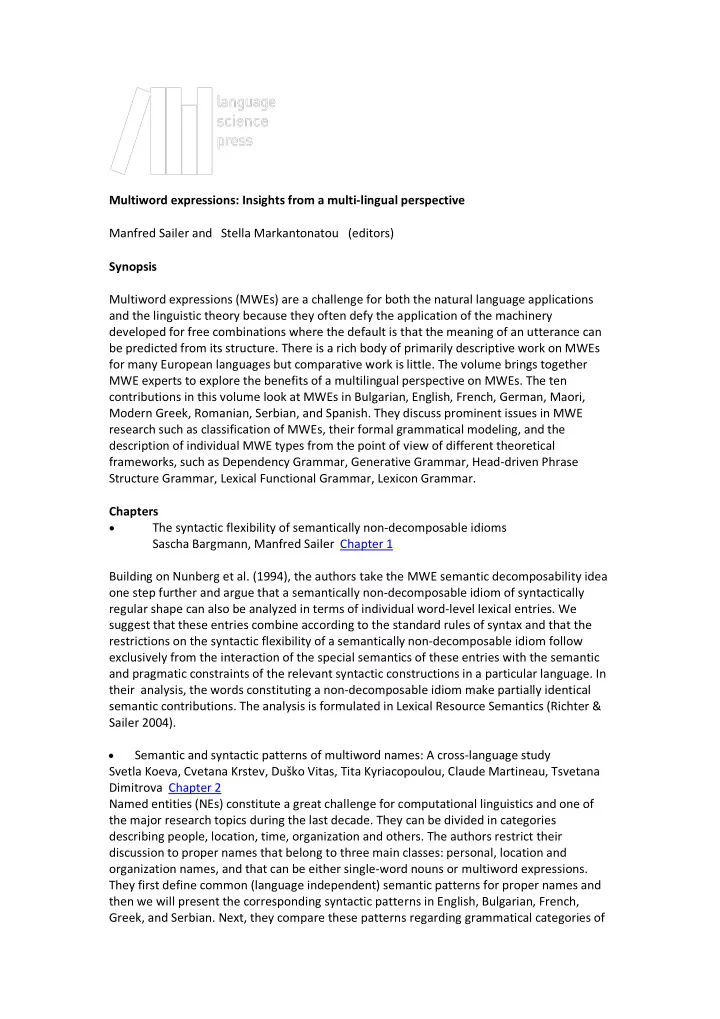

Multiword expressions: Insights from a multi-lingual perspective Manfred Sailer and Stella Markantonatou (editors) Synopsis Multiword expressions (MWEs) are a challenge for both the natural language applications and the linguistic theory because they often defy the application of the machinery developed for free combinations where the default is that the meaning of an utterance can be predicted from its structure. There is a rich body of primarily descriptive work on MWEs for many European languages but comparative work is little. The volume brings together MWE experts to explore the benefits of a multilingual perspective on MWEs. The ten contributions in this volume look at MWEs in Bulgarian, English, French, German, Maori, Modern Greek, Romanian, Serbian, and Spanish. They discuss prominent issues in MWE research such as classification of MWEs, their formal grammatical modeling, and the description of individual MWE types from the point of view of different theoretical frameworks, such as Dependency Grammar, Generative Grammar, Head-driven Phrase Structure Grammar, Lexical Functional Grammar, Lexicon Grammar. Chapters The syntactic flexibility of semantically non-decomposable idioms • Sascha Bargmann, Manfred Sailer Chapter 1 Building on Nunberg et al. (1994), the authors take the MWE semantic decomposability idea one step further and argue that a semantically non-decomposable idiom of syntactically regular shape can also be analyzed in terms of individual word-level lexical entries. We suggest that these entries combine according to the standard rules of syntax and that the restrictions on the syntactic flexibility of a semantically non-decomposable idiom follow exclusively from the interaction of the special semantics of these entries with the semantic and pragmatic constraints of the relevant syntactic constructions in a particular language. In their analysis, the words constituting a non-decomposable idiom make partially identical semantic contributions. The analysis is formulated in Lexical Resource Semantics (Richter & Sailer 2004). Semantic and syntactic patterns of multiword names: A cross-language study • Svetla Koeva, Cvetana Krstev, Duško Vitas, Tita Kyriacopoulou, Claude Martineau, Tsvetana Dimitrova Chapter 2 Named entities (NEs) constitute a great challenge for computational linguistics and one of the major research topics during the last decade. They can be divided in categories describing people, location, time, organization and others. The authors restrict their discussion to proper names that belong to three main classes: personal, location and organization names, and that can be either single-word nouns or multiword expressions. They first define common (language independent) semantic patterns for proper names and then we will present the corresponding syntactic patterns in English, Bulgarian, French, Greek, and Serbian. Next, they compare these patterns regarding grammatical categories of
dependent constituents, definiteness, distribution of clitics, word order and various alternations. Their ultimate goal is to build a universal framework for Named Entity Recognition (NER). MWEs and the Emotion Lexicon: Typological and cross-lingual considerations • Aggeliki Fotopoulou, Voula Giouli Chapter 3 In this chapter, the discussion is aimed at studying predicates that pertain to the semantic field of emotions, the focus being on Modern Greek verbal multiword expressions (verbal MWEs) and their counterparts in French. A core lexicon of verbal MWEs denoting emotion was extracted from existing Modern Greek lexical resources; the initial list was further extended and revised manually in view of corpus evidence. A classification of MWEs is proposed based on syntactic, selectional and semantic properties; an attempt to map the expressions identified onto their French counterparts was also made. The cross-linguistic study reveals similarities and discrepancies in the two languages, and highlights the interaction between MWEs structure and their underlying semantics, in that the intensity of the emotion denoted and the degree of fixedness of the relevant expressions seem to be highly correlated in both languages. • Flexibility of Multi-Word Expressions and Corpus Pattern Analysis Patrick Hanks, Ismail El Marouf, Michael Oakes Chapter 4 This chapter is set in the context of Corpus Pattern Analysis (CPA), a technique developed by Patrick Hanks to map meaning onto word patterns found in corpora. The main output of CPA is the Pattern Dictionary of English Verbs (PDEV), currently describing patterns for over 1,600 verbs, many of which are acknowledged to be multiword expressions (MWEs) such as phrasal verbs or idioms. PDEV entries are manually produced by lexicographers, based on the analysis of a substantial sample of concordance lines from the corpus, so the construction of the resource is very time-consuming. The motivation for the work presented in this chapter is to speed up the discovery of these word patterns, using methods which can be transferred to other languages. The chapter explores the benefits of a detailed contrastive analysis of MWEs found in English and French corpora with a view on English-French translation. The comparative analysis is conducted through a case study of the pair ( bite , mordre ), to illustrate both CPA and the application of statistical measures for the automatic extraction of MWEs. The approach adopted in this chapter takes its point of departure from the use of statistics developed initially by Church & Hanks (1989). Here, the authors look at statistical measures which have not yet been tested for their ability to discover new collocates, but are useful for characterizing verbal MWEs already found. In particular, they propose measures to characterize the mean span, rigidity, diversity, and idiomaticity of a given MWE. • Multiword expressions and the Law of Exceptions Koenraad Kuiper Chapter 5 This chapter proposes the existence of a linguistic universal, the Law of Exceptions. It hypothesizes that a relationship exists between the grammar of a language and its lexicon such that all regularities expressed in the grammar of a language are matched by exceptions which are manifested in the lexicon of that language. It is also proposed that lexical idiosyncrasies are of two types. Type 1 idiosyncrasies are in the nature of arbitrary restrictions on options provided in the grammar while Type 2 idiosyncrasies involve breaches of the rules of the grammar. To test this law requires an initial examination of the
Recommend
More recommend